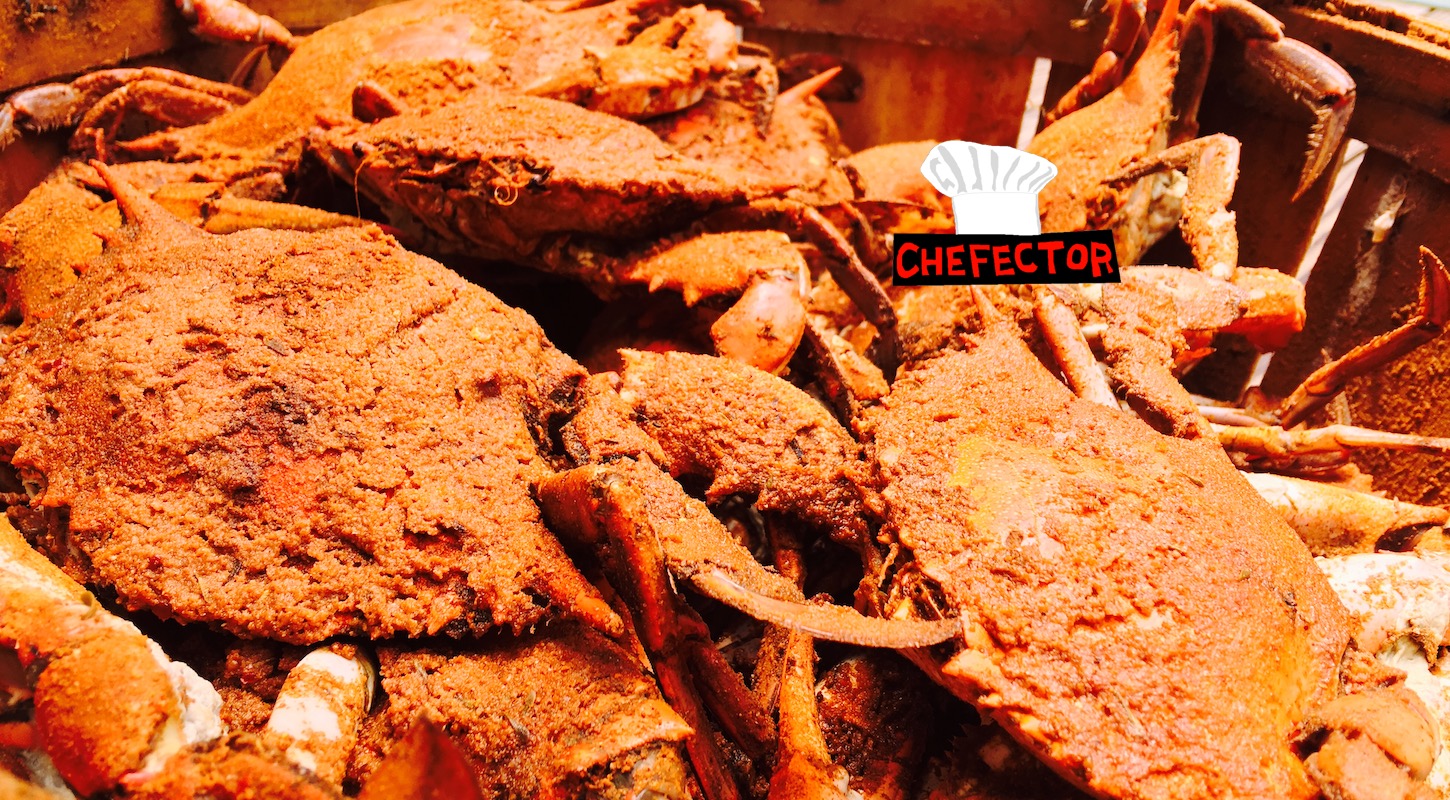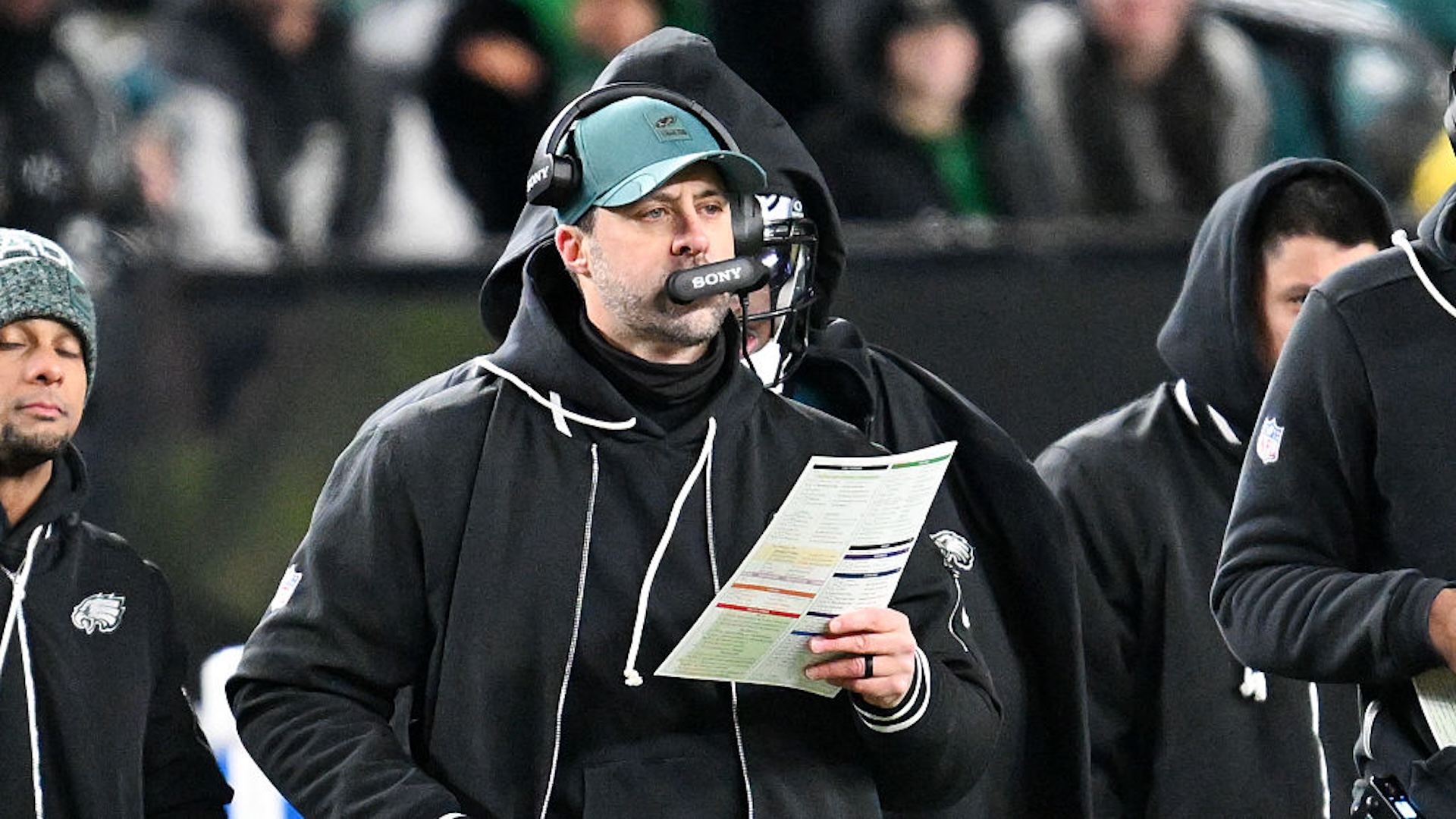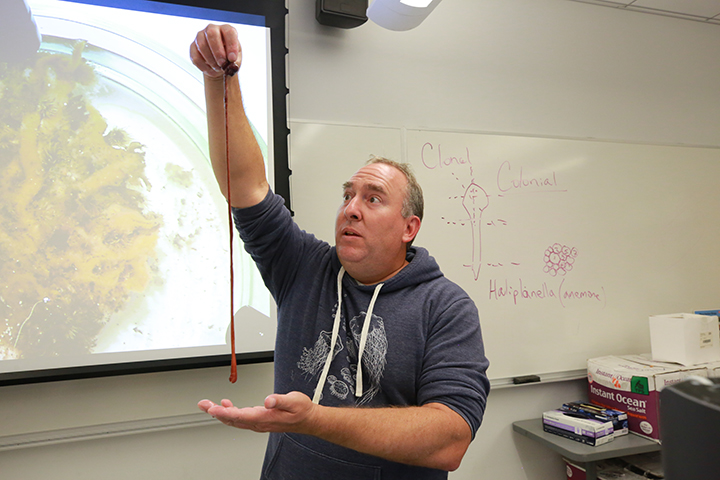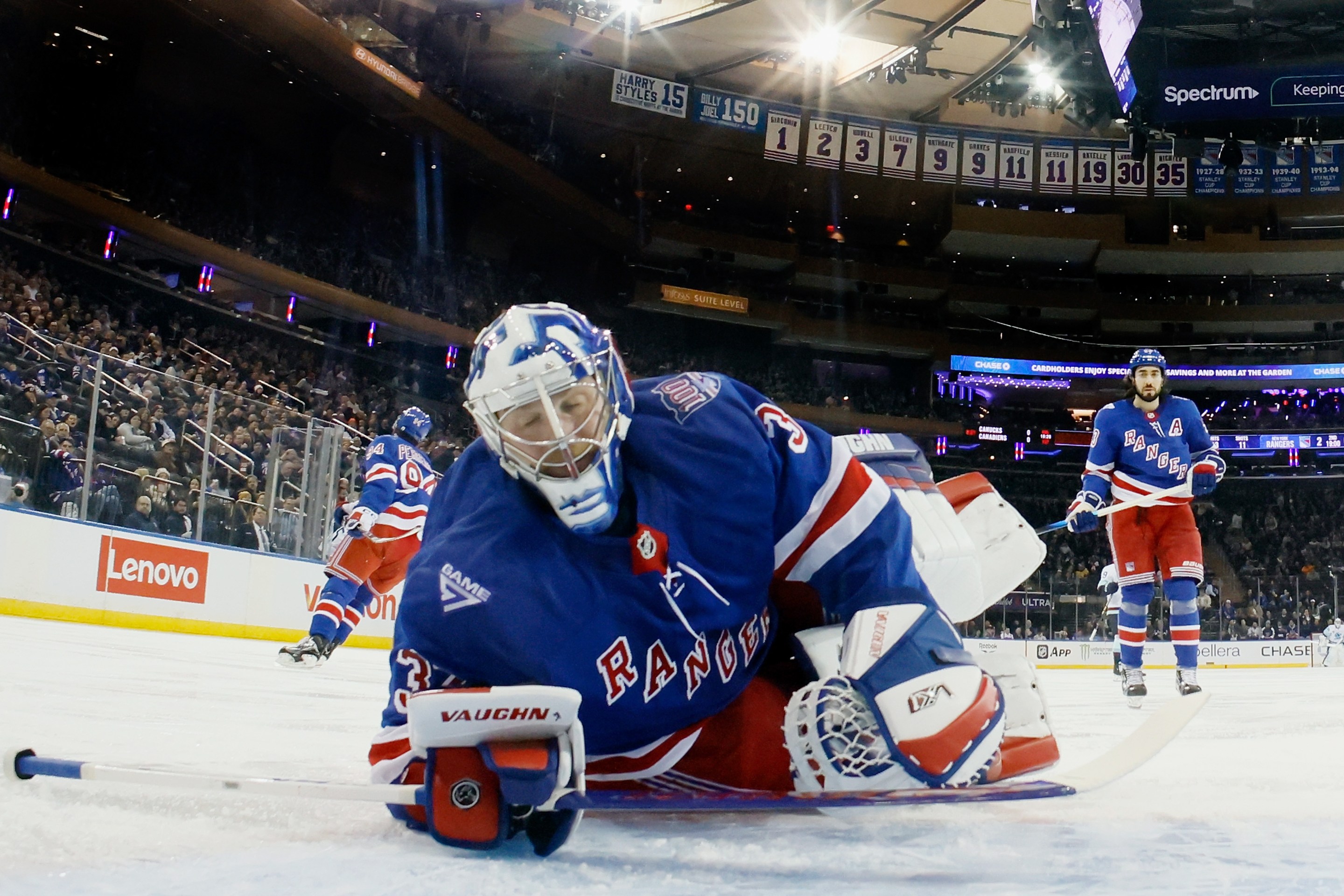In the Chesapeake Bay watershed, where I have lived nearly all of my life, blue crab season runs from April through the end of October, but in practice it has always been neat enough just to follow the inverse of the folkloric "R" rule of oysters: Eat oysters only in the months with "R" in their name (September through April) and crack crabs only in the months without (May through August). The early season crabs tend to be tiny and not worth the trouble, and by mid-September and October, in pre-climate collapse times, it'd be too rainy and/or cool to enjoy crabs in their best setting, outdoors, in the heat, with a cold beverage in a sweating plastic cup. If you stuck to May through the end of August, you could still enjoy plenty of crabs.
That's how I've pretty much always done it—the crab part anyway. As the Bay ecosystem has struggled through and been laid low by pollution and climate change, and crab populations have shrunk to terrifying lows, the temptation to indulge in offseason crabs only gets easier to resist: All you have to do is not eat them for two thirds of the year, and you are doing at least a little something to give these precious, beleaguered crustaceans a shot at reproducing and continuing to exist.
On top of that, crabs are not cheap and in my experience never have been, and I have generally not had extra (or any) money laying around; if in a given year I'm only going to be able to afford, at most, one or two of the kind of real-deal crab-cracking parties that result in my own personal shell-pile reaching heights difficult to see over, it is better to wait until later in the season, when the crabs will be big and delicious. If nothing else, the crescendoing late-spring/early-summer anticipation of crabs is better than the realization that you've just eaten your last one for eight months. For the past 13 years or so my custom has been to hold off until Father's Day weekend, and then get a bushel and invite everybody over.
When I was a kid, and my mom's family—leathery Annapolis types, cut them and what comes out smells like Old Bay Seasoning—would pitch a crab feast, the crabs were always brought to it alive in big wooden bushel baskets, and cooked on site, in whatever field or park or backyard; I have hazy childhood memories of flat propane camping stoves and big huge clanging graniteware crab-cooker pots. Then for various off-topic reasons the family kinda atomized, or maybe we just atomized away from it, and when our smaller little gang would have crabs, it'd be at a crab shack, or the crabs would be cooked by the grim steamer-room guy at the wharf or wherever anybody bought them and then brought home already cooked and eaten before they could get cold. That was always fine.
Now I live a little too far from the water for that to work. There are seafood shacks near me that serve preposterously marked-up cooked crabs, but that's a real roll-of-the-dice type of deal—they charge just as much for shitty crabs as for good ones, and you don't get to know which kind you got until they're dumped on the table in front of you—and anyway I want to eat them at home, outside, and get myself absolutely disgusting with scalding crab liquids and tomalley without worrying that a stranger will think that I am a werewolf and shoot me. Meanwhile it's a 45-minute drive to the nearest place that retails reliably good and alive blue crabs; getting them cooked there means turning an already 90-minute round-trip into an even more flagrantly indefensible two-hour ordeal, and by the time I get back the crabs aren't even hot anymore. This is still largely acceptable to me, in the sense that I will do it if that's the only way to eat decent crabs in absurd quantities at home in the sunshine. But also, even if just on principle, it is unacceptable.
I happen to own a cartoonishly gigantic 40-quart stockpot with a steamer basket insert. You can very easily imagine the witch cooking Hansel and Gretel in this thing, together at the same time. I bought it online years ago without doing the least checking to find out whether a plausible domestic kitchen can even fit a stockpot that size. It is too big for making practical quantities of stock; it is literally too big to fit on my stove. I have no real justifying use for this thing for a solid 36 weeks of the year. But! In the summer, when it's hot outside, I make the 45-minute drive, get a live bushel of crabs, bring them home, and cook them in this sucker, over a charcoal fire, on my grill. It rocks. This blog will be about how to do that.
This all seems sorta impractical, or impracticable, compared to a blog about, like, how to poach some normal eggs. You can get eggs pretty much anyplace that has grocery stores or supermarkets, whereas there are whole wide swathes of North America, to say nothing of the rest of the world, where it is for all practical purposes impossible to get anything even broadly analogous to one living blue crab, let alone a bushel of them. For that matter, the people who live in the places where live blue crabs can be gotten, and who are interested in getting them, may very well already know all they care to know about how to get and/or prepare them. And for that matter, the oceans are dying; it seems horribly, horribly possible that information about how to cook blue crabs will go the way of information about how to breed dodo birds, like, within my lifetime. Oh well. If there are instructions for how to build a rockin' chariot on the wall of a musty old tomb somewhere, they're probably not without some kind of archaeological value.
In the meantime, maybe you can cook some crabs. If so, here is how you can cook some crabs. Or anyway how I cook some crabs.
The necessary equipment is pretty straightforward. This job requires a very large pot (this is the only time I could ever lord my 40-quart stockpot over literally anyone), with a tight-fitting lid, and preferably with a big steaming/draining insert that fits in there even with the lid firmly in place. Absent that, some steamer pots have a raised rack in them, so that the food sits above the boiling liquid; this is also good. One time I cooked some crabs in the huge pot by setting a couple of bricks down in the bottom of the pot and laying a wire drying rack on top of them. It worked fine. You get the idea. If you have a heavy rock or something similar (a third brick?) that can sit on top of the lid to press down on it, that's good.
This job requires a charcoal grill (or a propane one I suppose, or, theoretically, a camp stove, or maybe just some way of suspending a large pot over a campfire), and a big bag of charcoal (unless you're using some other kind of grill). It requires heavy duty gloves, like the kind for pulling weeds or shucking oysters; these are for handling both angry living crabs and also the very hot steaming insert when it must be taken out of the pot later on. A sturdy pair of tongs or two would not kill you to keep handy during all of this.
(For cracking and eating the crabs, people like their nutcrackers and their mallets—seemingly every store in Maryland has wooden mallets all summer—but in my abundant experience the best tool for any given part of the crab-cracking excursion, apart from your nimble fingers, is a regular old dinnerware knife with a reasonably pointy tip.)
The job also requires, necessarily, some blue crabs. I am sorry to inform you that these must be alive; it simply will not do to cook already cooked crabs, and crabs that are dead but not cooked are not safe to eat. Indulge me on this subject, about which I care way too much.
The state of Maryland and various other, uh, municipalities (?) have various laws and regulations about catching crabs, with which you needn't bore yourself. It is fine, for the purposes of the regular doofus buying some crabs to cook and eat, to collapse all these various rules into the principle that, for the survival and sustainability of the crab population, it is much, much, much better to buy adult male crabs than it is to buy female crabs. It is even easier to just collapse this all the way to "Don't buy female crabs," even if that goes well beyond what the rules say. If you simply do not buy female crabs, then you simply do not have to worry about the finer points of the regulations about when and how many of them anybody may catch or sell or whatever.
This is a wise approach for the crab buyer, because you cannot always rely upon just anybody who happens to be selling some live crabs to have stayed assiduously within the rules about how many to catch, and when, and the distribution of males and females. If you do not participate in making it profitable for anybody to have flouted those rules, well, if that is not quite the most you could do to protect crab populations from overfishing (it's probably not even the second-most, since it's not "simply declining to eat crabs"), it's something. It is, for your purposes, the easiest of somethings.
So you will want male crabs. Thankfully, in my experience, crab, uh, brokers (?) usually have the crabs all sorted out by sex and weight and such, making this part easy. Just in case, though: On the pale underside of each crab, there is a flat flap of shell called the apron, pressed tight against the crab's body; on the males the apron is narrow and pointy; on the females it is wide and half-circle shaped, except for at the midpoint of the arc, where there is a lil' point. There is no confusing one for the other.
Oh hey, speaking of the pale underside of the crab! Crabs molt. Did you know that? In their lifetime, their body—the delicious meat, that is—fattens up inside their shells; then they have to shed their hard shell because it doesn't fit anymore; then they grow a new shell that is much bigger and has a lot of empty space in it, so that they can fill it out as they continue growing.
So you might see two crabs that are the exact same size, in terms of their outer shell, but one of them just got that size of shell yesterday, whereas the other has been wearing that size of shell for quite a while and is just about to grow out of it. The former crab, when you crack and eat it, will be light and mostly empty and disappointing; the latter will be heavy and bursting with crabmeat and delicious. You can tell them apart by looking at their underside: The new shell, the one that is largely empty, will be a clean, pale, bluish white; the old shell, the one that is packed tight with heavenly food, will be yellowish and will have spots of rusty brown up by the front of the crab.
If you are buying a bushel of crabs from a wharf or a seafood market or whatever, they are not going to let you inspect each crab. You can tell them you want "heavy" or "fat" crabs, but of course pretty much everybody wants those, and there is nothing special about being the person who says so; a kindly bushel-packer might take care of you, particularly if you are known to be an extravagant cash tipper, but, like, they have to sell the light ones, too. At some international supermarkets they might just have a bunch of crabs in a cold more-or-less self-service bin; in this case, maybe you want to try to look out for the rusty ones, if there are any. Information about how to tell the heavy crabs from the light is most useful to anybody who follows Laura Wagner's instructions for catching their own crabs straight out of the water; throw the pale white ones back, both to save yourself the disappointment of cracking a crab filled with mostly seawater and also so that the newly molted crabs can eventually become heavy, rusty ones, and maybe make some baby crabs in the meantime. But also it just feels good to write it somewhere, OK?
Importantly, at fish markets and wharves and such, the crabs will tend to be sorted by size, which is not the same thing as weight. It's possible for all the biggest crabs to be empty and the smaller ones full. Still, all else being equal, you'd rather have a bigger crab than a smaller one—if nothing else, the work of extracting its meat will be a little bit less delicate. This is why the bigger crabs are a lot more expensive!
OK. Enough on crab selection. You will also need what various establishments like to call "crab seasoning" but which, let's be real, might just as well be Old Bay seasoning. It pains me to name a brand! But the fact of the matter is, any given Maryland blue crab cookery's seasoning, no matter how Special or Secret or Uncle Bob's it might claim to be, has basically the same (stupidly long) list of ingredients, only in different proportions. You can waste your time fiddling with every spice in your cupboard until you hit on it, or you can just split the difference between literally all of them with a big tin of Old Bay. It's fine. If you're cooking a densely packed bushel of crabs, I think that you should go ahead and plan on using all or nearly all of a 24-ounce can of the stuff.
Many places and people steam their crabs over equal (or unequal) parts water and vinegar. That's grand. It's also fine to just steam them over water. It's probably not fine to steam them over straight vinegar. I wouldn't do it! If you want to include vinegar, by all means do. At the very least, you need water. Enough to fill at least the bottom couple of inches of your big pot.
Let's cook these dang crabs.
OK so you have your crabs, and they're alive, and it's kind of terrible. I'm sorry. The terribleness of this is a sort of weird and hard thing to hold in balance with how delicious the crabs will be. Let's not dwell on it. Make a hot fire in your grill. If you're using charcoal, you don't need to wait until the fire is all the way established and the coals are ash-covered and orange-glowing; you can put the cooking grate on top of them, set your pot (with the water inside) on top of it, clap the lid on there, and let the water come to a boil.
Now, if you have a basket-like steamer insert, the next part is the part that sucks. With your heavy duty gloves on, start filling the basket with crabs. They may be hostile; they will not like being picked up. I don't know what to tell you if your merciful heart makes you pity them (mine always does), other than that it's probably not realistic to imagine that you will drive them to the coast and return them to the ocean, and so they will have to be cooked and eaten if they are not to be wasted altogether. Grab each one from behind; avoid the pincers, and be ready to clap the bushel closed if they get too rowdy. When the steamer basket thingy is half-full, dump a bunch of Old Bay on the crabs, then continue filling the basket. If you can fit the entire bushel of crabs in there, that's great, but it's fine if not; it'll take a while for any plausible gathering of people to eat this first batch, so you might as well cook a second, rather than letting a bunch of crabs get cold. In any event, whenever you're done putting crabs in there, dump the rest of the Old Bay on them.
That's just about it, uh, mercifully. Thankfully. Working quickly so as not to let too much steam escape, whisk the lid off the pot, lower the steamer insert down in there, and clap the lid back on. 25 minutes will do it; 30 to be sure. The crabs will come out red and extremely hot and, ah, not alive anymore, and incredible-smelling. Dump them out onto a picnic table covered in several layers of newspaper or some of those disposable paper tablecloths you can sometimes get in the little party-favor section of the supermarket.
People serve hard crabs with different accompaniments. My mom likes a little dish of malt vinegar for dipping bits of crab into; I prefer drawn butter, or nothing; my wife likes a little heap of Old Bay seasoning where she can occasionally touch a hunk of crab to it for some extra salty punch.
Cracking the crabs is a whole thing. People have takes, some of them militantly held. I will give you a good start, and you can figure it out from there. Peel the apron down and off on the underside of a crab; this will reveal an open slot in the back of the crab's body. Slip the blade of your butterknife in there and, using it as a lever, remove the red upper carapace from its body. Behold what it previously hid! The feathery looking things are gills, and not for eating; the yellow (or greenish-yellow, or sometimes goldenrod) stuff is tomalley, the crab's hepatopancreas. It is delicious, especially if it's yellow and semisolid; you know a true Crab Sicko (such as myself) if they prize this above even the meat.
OK, so, the crab has some legs on each side: Big claws toward front, then a couple of spindly pointy guys, and then a blunt little swimming fin at the back. The little swimming fin is for swimming, naturally, and crabs do lots of this, so just inside the crab's body on either side, where the body meets each swimming fin, are the two biggest bite of crab you will find in there. What I do is, with my hands which are covered in disgusting leathery callus in no small part from a lifetime of picking crabs with them, I break the crab's body in half down the middle, and then with my fingers I pick the shell away from that big lump of crabmeat down by each swimming fin; then, gently, I can pull on the fin and the whole big lump will come off at the end of it, like a lollipop of delicious crabmeat.
I'm not explaining how to do the rest! This blog is already like 50,000 words! Here, watch this lady do it, who is better at cracking crabs than I ever will be at anything:
Happy feasting.






